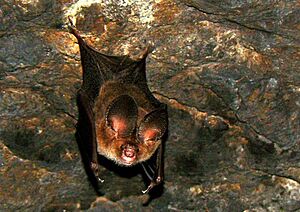Fulvus roundleaf bat facts for kids
Quick facts for kids Fulvus roundleaf bat |
|
|---|---|
 |
|
| Location: Manpeshwar CaveDahisar, Mumbai | |
| Conservation status | |
| Scientific classification | |
| Genus: |
Hipposideros
|
| Species: |
fulvus
|
 |
|
| Fulvus roundleaf bat range | |
The fulvus roundleaf bat is a type of bat. It's also known as the fulvus leaf-nosed bat. Its scientific name is Hipposideros fulvus. This bat belongs to the family called Hipposideridae.
You can find these bats in several countries across Asia. They live in places like Afghanistan, Bangladesh, China, India, Myanmar, Pakistan, and Sri Lanka.
Contents
About the Fulvus Roundleaf Bat
How Scientists Named This Bat
Scientists give every animal a special name. This helps them study and understand different species. The fulvus roundleaf bat got its name in 1838. A British scientist named John Edward Gray described it.
The first bat studied was found in Madras, India. Today, that city is called Chennai. Gray noticed the bat's fur was a reddish-yellow color. This color is called "fulvous." That's how the bat got its species name, fulvus.
What Does This Bat Look Like?
The fulvus roundleaf bat is a small creature. Its forearm, which is part of its wing, is about 38 to 44 millimeters long. That's roughly 1.5 to 1.7 inches.
These bats usually weigh about 8 to 9 grams. That's less than half an ounce, like a couple of paper clips! They have big ears that are rounded at the tips. Their fur can be different colors. Some are pale yellow, others are golden orange, and some are pale gray.
Where Do These Bats Live?
The fulvus roundleaf bat lives in Central and South Asia. You can find them in many countries. These include Afghanistan, Bangladesh, China, India, Pakistan, and Sri Lanka.
They can live in many different places. These bats are found from sea level up to high mountains. They can live at elevations as high as 2,600 meters (about 8,500 feet).
Protecting the Fulvus Roundleaf Bat
As of 2019, scientists have looked at the fulvus roundleaf bat. They decided it is a "least-concern species." This means it's not currently in danger of disappearing. The bat lives in a wide area, even if its population is spread out.
Scientists don't think its numbers are dropping quickly. However, these bats don't live in very large groups. Their homes, called roosts, can be disturbed by people. It's important to protect these roosts to keep the bats safe.


